How do you make a discussion of live rock hitchhikers exciting and novel? By taking your cues from one of the best books in the world, of course. For instance, if you start by checking for an entry on “live rock,” in The Hitchhikers Guide to the Galaxy, you find the following entry:
On earth, before it was destroyed to make way for a hyperspace bypass, monkey mammals called humans sometimes enjoyed collecting fish and corals in a glass box. Inside that box, they would pile a bunch of expensive rock that they called ‘live rock.’
The rock itself was not alive, but it was teeming with more biological activity than a Glugarian hyperspace rest stop toilet.
“Don’t panic!” Grab your trusty towel, and settle in for a read. This guide will help you separate the good from the bad and the bad from the very ugly live rock hitchhikers you might find in your aquarium. (See what I did there?)
Table of Contents: Live Rock Hitchhikers
Douglas Adams wasn’t far from the mark. For an inanimate structure, live rock comes with PLENTY of tagalongs you’re not usually looking to add to your tank. And trying to figure out which of those live rock hitchhikers you need to worry about versus the ones you can allow to pass inspection can get tricky. Good thing you have this trusty guide to help you out. If you’re in a rush (maybe you spotted the dolphins making a break for it), feel free to skip down through the links to the section you’re most interested in. Otherwise, let’s explore the galaxy of saltwater hitchhikers together.
What is Live Rock?
Let’s start by answering the most basic question: What is live rock? To get to the bottom of that answer, we need to go to the beginning – literally.
Coral reefs are diverse underwater ecosystems where fish, corals, and other invertebrates thrive and compete. Plenty of people compare them to underwater cities. And that works perfectly for our description of live rock. Live rock serves as the buildings to provide the city with its structure. Then the remainder of the reef life can establish a home on that rigid base.
Bacteria and invertebrates live in, around, and on the rock. Then you have corals and other sessile (non-mobile) invertebrates that attach to the live rock and carve out their space on the reef. In no time, there’s a thriving ecosystem. Without the live rock, though, you wouldn’t have any of it.
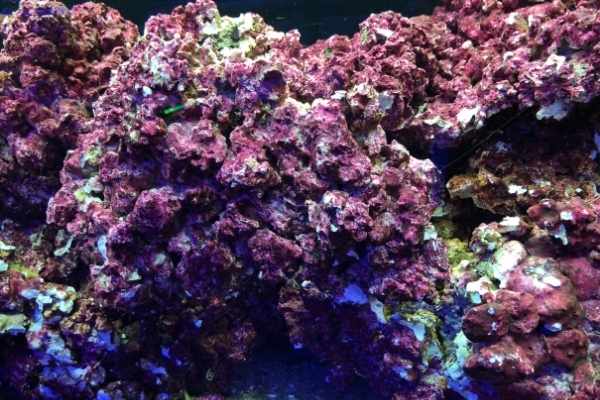
Why Do We Use Live Rock in Our Reef Tanks?
Clearly, the ocean lives live rock. And it creates beautiful structures such as the Great Barrier Reef. But why do we want to bring it into our reef tanks, where we need to battle with live rock hitchhikers? Easy, those same base structures provide the aquariums with some key benefits:
- Create a natural look (replicating a natural reef)
- Harbor beneficial bacteria that help to purify the water
- Provide a structure on which corals can grow (precisely as they would in the seas)
- By aquascaping live rocks (laying them out in a structured way), we can create a range of conditions within the same tank suitable to different aquatic species
But the most interesting reason we add live rock to a reef aquarium?
Add to the biological diversity of the aquarium by transporting hitchhikers from the reef into our tank.
That’s right, we’re TRYING for live rock hitchhikers! Live rock is like opening an “invertebrate of the month” box and putting it in your tank. You never know what you’re going to get. And that biodiversity often enhances your aquarium. (We’ll also deal with the darker side of the invaders, but let’s try to think positive for a moment)
Ultimate Guide to Live Rock Hitchhikers
This guide aims to share some of the good, interesting (or neutral), and bad live rock hitchhikers that commonly stow away and make the journey into our tanks. Sure, they might scare you a bit (no one likes freeloaders), but you’ll find some helpful members in the group. And sometimes, you get a nifty live rock hitchhiker that turns your reef tank into something spectacular. It’s always good to know what might come along for the ride in all of those nooks and crannies. (Incidentally, this is why you should ALWAYS quarantine your live rock)
Now, that list could end up almost limitless, and I’m only one person. So I could use your help. If you don’t see interesting critters on this list that you feel warrant notoriety, please leave a comment. I want to ensure this remains the ULTIMATE guide, after all.
Helpful Live Rock Hitchhikers
My family members think we’re crazy (okay, I’M crazy) for spending $50-$100 for the rock that goes into our tanks. To tell you the truth, they’re probably right. But we’re also crazy about our tanks. And we know that creating biological diversity in our tanks is beneficial to the animals in our care. Not to mention it makes the aquarium more interesting to watch.
And not every live rock hitchhiker brings doom and gloom. A few can pitch in and make your tank a nicer place for everyone. That’s what these helpful stow-aways accomplish. They’re the ones we hope to get whenever we add new live rocks to the tank.
Nitrifying Bacteria
Nitrifying bacteria are the unsung heroes of live rock. You can’t see them (so, of course, checking over the live rock in search of this hitchhiker won’t work), but they’re there. This live rock hitchhiker pulls toxic ammonia out of the water and turns it into relatively harmless nitrate. (And you know how important it is to keep that water parameter under control)
You don’t HAVE to use live rock to seed your biological filter with nitrifying bacteria. However, live rock serves as a natural substrate to help support bacterial growth. Some people actually start cycling of their tank by adding uncured live rock to their tanks. That adds a natural source of ammonia (via organisms on the rock dying and decaying). Then the nitrifying bacteria convert the ammonia to nitrate. Boom! Cycled tank with minimal effort.
Coralline Algae
Live rock is so interesting to look at because it contains different textures and colors. And some of that texture and color comes from a type of algae called coralline algae.

Coralline algae is a “good” algae (i.e., one you WANT to see show up in your tank). Like the corals you propagate, these algae use calcium to form the backbone of their structure (this is why they’re known as “coralline”). It’s why they’re common live rock hitchhikers in the first place – there’s calcium in all of those crevices. And when they start to move throughout your tank, they find more and more to absorb and utilize.
And while you might freak out about seeing these algae plaques show up in your tank, you shouldn’t. The presence of coralline algae on your rocks (and glass) is a sign of a healthy tank. Think of it this way: the algae are like green grass (without weeds) in a healthy lawn. They demonstrate that your aquarium’s thriving. If you’re really upset by the algae, they’re easy enough to clean from your tank equipment.
Pods
Pods – as they’re affectionately called in our hobby – are some of the most sought after and desired live rock hitchhikers. Why? Easy. These little critters serve three important functions in a reef tank:
- Tiny as they are, they’re part of the clean-up crew.
- Having pods around is like having an ant farm (you can watch them crawl around, working within the tank).
- Most importantly, pods ring the dinner bell for some of your fish and invertebrates. They’re one of the most nutritious and natural foods for an aquarium.
Attracting pods to live in and populate reef tanks is a top goal when purchasing live rock. They’re still considered live rock hitchhikers, but due to their high demand, you almost want to elevate them to esteemed guests. When they pop out of those crevices, you get excited. Next to nitrifying bacteria, they’re an exciting find (and you can SEE them).
Scientifically speaking, there are approximately a gazillion different species of pods in the world (yes, that is a scientific number). For the sake of simplification, though, we reefers are generally only interested in two types:
- Amphipods
- Copepods
Amphipods
Amphipods are the larger variety of these live rock hitchhikers. They’re easy to spot with the human eye. (Digression: Where did that expression come from? Was there a point when people tried to use eyes from other animals as an experiment to help see things? That’s weird. And gross) Amphipods look a little like tiny shrimp. They’re meatier options for your fish and invertebrates. And when they’re not serving as a food source? They scavenge algae and detritus from the tank.
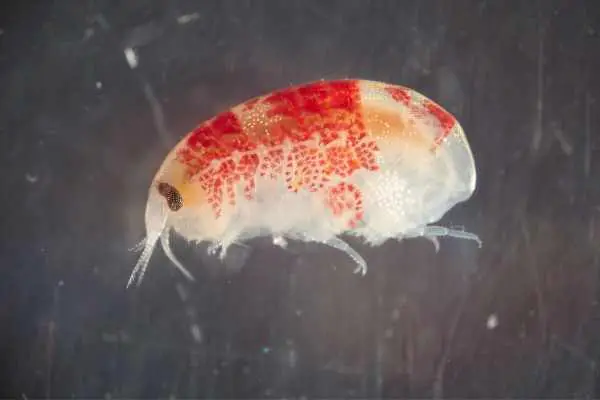
Copepods
Copepods are much smaller. In comparison, they come in as tiny specks compared to the much larger amphipods (we’re talking the 0.2-10mm range). Copepods look a bit like the underwater love-child between a pill bug and a flea. These little guys are important food sources for plenty of fish (such as the Mandarin dragonet). And while they’re bitty, they still do their part as the clean-up crew. They take care of nuisance algae for you.
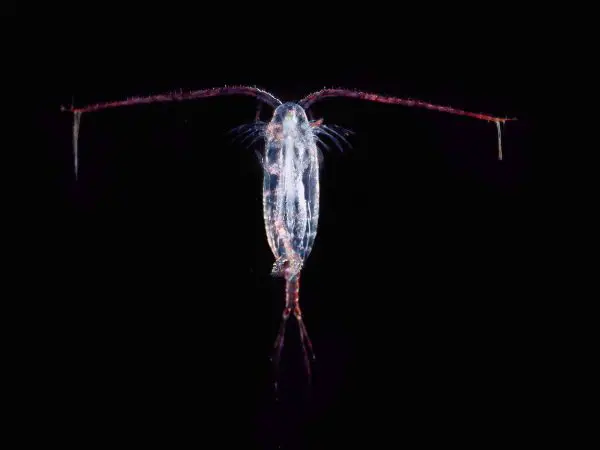
Sponges
Another group of helpful live rock hitchhikers is the marine sponges. Sponges are filter feeders and come in a variety of colors and interesting growth formations. As you might guess, any filter feeder is a helper in a reef tank. They remove floating debris from the water, helping to cycle out unnecessary wastes. And they won’t outcompete your corals for space. Sponges and coral often share room in the ocean, offering mutual benefits to one another.
The delicate structures often dry out when transported on uncured live rock (think of the dried-out sponge you keep around the house). And that can cause problems when the rock gets placed in your tank, uncycled. The sponge won’t have any resources when it rehydrates. But when cured live rock (carrying sponges) is carefully transplanted into a tank, they can proliferate and thrive in typical reef water conditions.

The presence of pineapple or other sponges is a sign of a healthy tank.
Small Starfish
Another group of common live rock hitchhikers is starfishes – the itty-bitty kind. (Obviously, you won’t miss the sight of a hefty starfish clinging to the side of a rock) They come in a variety of shapes and sizes. Correction – they all come in the shape of a star, but the size and shape of the arms vary from species to species. And these little shooting stars are a delightful find scattering around your aquarium.
Asterina Starfish
The little fellow in the photo below is an Asterina starfish. And the jury is still out on where to file this live rock hitchhiker. Some hobbyists feel they’re harmless and leave them alone. But others? They notice white marks around their corals (the base of the coral is usually the first sign). That’s a red flag that the Asterina starfish have decided to start snacking on the coral polyps. And that means they’ve crossed the line from cute little visitor to horrible pest. You need to decide for yourself.
And the big problem comes with how quickly this live rock hitchhiker can take over. See how one leg of the star in the picture is significantly longer than the other? Like your corals, these starfish can reproduce asexually by breaking off legs and growing a new starfish (it’s known as fissiparous reproduction). It’s a really cool thing to see, and you’ll feel great that they’re flourishing in your tank. At least until you have a million of them all over the glass. (And that’s the “pest” part of the equation)
If you feel like your Asterina houseguests have overstayed their welcome, you might want to invest in some harlequin shrimp. They LOVE these starfish and can quickly make short work of the pests. However, they ONLY eat starfish, so you’ll need a backup plan (or you could always pick up new live rock and hope for a fresh batch).

Brittle or Serpent Starfish
The serpent starfish group may or may not be bad news (and it isn’t a debate in the way of the Asterina). Many brittlestar and serpent starfish species are super tiny and won’t cause any problems in your tank. You’ll probably even enjoy having them around. But some of the larger individuals are opportunistic predators. And when opportunistic predators live in a tank 24/7, they generally find an opportunity. That’s when these live rock hitchhikers turn into a problem. Yoda wouldn’t be happy with us judging them by their size, but that’s how I’d determine if it was a big deal or not.
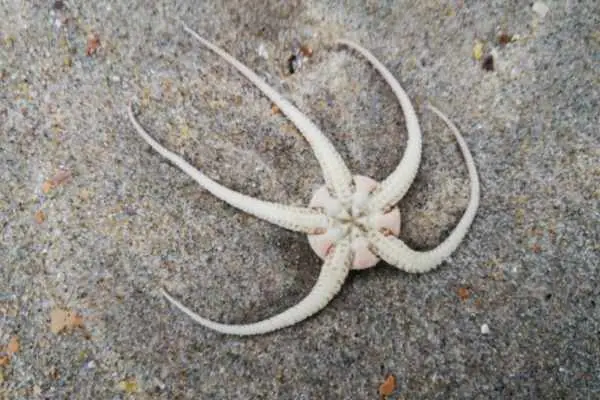
Learn more about reef safe starfish here.
Snails
When you start to consider live rock hitchhikers, you may not consider snails. After all, these mollusks need to stay hydrated, right? But it’s easy for them to duck into a shell and seal the operculum (the “door”) and remain safe. Or you can have the larval stage snag a ride. And when the live rock enters the tank, the babies find a new home. Some snails you DON’T want to see setting up camp in your aquarium, but not all of these little shelled wonders are so bad.
Stomatella Snails
Snails get a slow rep. But Stomatella snails move FAST through a tank. And these live rock hitchhikers are mollusks you won’t mind having around. They feed on microalgae, helping keep your tank clean. You might actually mistake them for something other than a snail, though. The shell is much smaller than you see in most snails, giving them a slug-like appearance, as you can see in the picture below.

Corals
You know you’ve hit the jackpot when the live rock you purchased has coral attached. Talk about a helpful live rock hitchhiker! You don’t even need to purchase an additional frag!
When I first started in the hobby, I remember obnoxiously picking through the live rock at my local fish store (shout out to The Hidden Reef) to find pieces of live rock with interesting stuff growing on it. And I really want those coral polyps. At the time, my tank sucked. Most of what I brought home didn’t make it, unfortunately. But one time, in particular, I brought home some live rock with pink stuff on it that eventually grew into the dramatic beauty you see in the photo below.

Those green zoanthids hitchhiked their way into my tank and flourished. However, you need to be careful with this plan of attack for adding corals to your reef tank. Green star polyps and other soft leather corals are also possible live rock hitchhikers.
Interesting Live Rock Hitchhikers
Sometimes you end up with live rock hitchhikers that fall somewhere in the middle of the spectrum. They aren’t terrifically helpful or terribly harmful. Instead, these critters find their way into our tanks and hearts, adding a little bit of texture and complexity to the ecosystems we have created. Whether you decide to let them stick around or chase them out is up to you.
Worms
Worms come in every “flavor.” You have roundworms, flatworms, segmented worms, and bristle worms, and each one can bring something to your reef tank. Burrowing deep into every hole and crevice, they’re common live rock hitchhikers. Some of them fall into the harmful category (which we’ll get to in a minute), but others? They’re not so bad. They may even enhance things a bit.
Christmas Tree Worms and Fan Worms
Fan worms are interesting little live rock hitchhikers. They’re polychaetes, meaning they have multiple legs extending from their bodies. They use the extensions as a means to sift food particles. These delicate little filter feeders look like fans (hence the name “fan worms”). When everything settles into a relative calm in the tank, the fans come out and sift particles from the water. When disturbed, the fans duck back into protective tubes.
If you want, think of fan worms as a sign of a healthy tank. Their growth and reproduction in your tank mean you’re doing something right. The only way they can survive is if you have the right balance of nutrients to support the growth of their tubes. They don’t disturb corals or interfere with the feeding of polyps. And they’re often beautiful to look at – when you catch those extended fans.
Christmas tree worms are a popular type of fan worm. If you see a picture of these live rock hitchhikers from the right angle, they resemble a psychedelic Christmas tree forest.
Since Christmas tree worms generally burrow into porites corals, it means you scored a 2-for-1 special on that live rock.

Spaghetti Worms
Spaghetti worms are polychaetes, making them a relative of fan worms and bristle worms. Like the fan worms, they have a hard shell that protects their body from predators. Then they extend their feeding tentacles for respiration and feeding. And the shell is what allows them to hide away as live rock hitchhikers.
But while fan worm appendages look like fans, spaghetti worm appendages look like – any guesses? Right. Milky or translucent weird string. (I don’t think it looks much like spaghetti. That’s weird if you thought that) They set up in the sand with their tentacles to pick up detritus that drops to the substrate. And while they look a bit strange, they’re a handy member of the clean-up crew to have around.
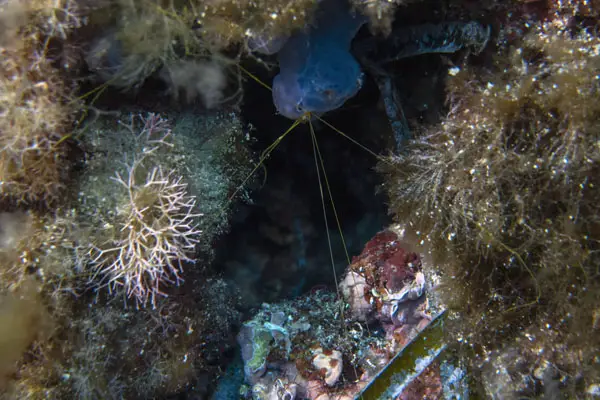
Bristle Worms
In my opinion, bristle worms are one of the most under-appreciated and (dare I say wrongfully hated) live rock hitchhikers that you will run into. I’m not really sure why, other than that they’re ideally suited to live in reef tanks, evading total annihilation. They work as tireless clean-up crew members, emerging under cover of darkness to pick up leftover waste and detritus. Oh, sure, the resemblance to a centipede isn’t attractive. But you’re probably not going to see them regularly.
There ARE dangerous bristle worms (the fireworm group) that pose a hazard to your fish and you (if you get stung on your bare hands). However, those varieties are scarce. I personally haven’t heard of a contemporary sighting in the home aquarium. The majority are harmless.
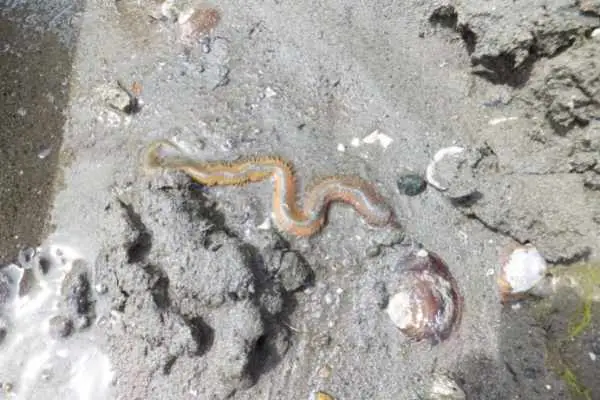
Problem Algaes
Okay, realistically, no one LIKES algae. It tends to cover your glass and make your tank look unclean. But algae are a necessary part of many reef tank setups. Plenty of fish rely on algae for their diets. So, for this section, I will use the phrase “problem algae” to refer to the group of alga and non-alga species that represent live rock hitchhikers and turn into unwanted problems within reef tanks.
Dinoflagellates
Dinoflagellates are tiny, single-celled organisms that resemble ugly brown algae. They’re usually only problematic in a new aquarium. In fact, you expect to see this “ordinary” live rock hitchhiker, even though it’s problematic. The tiny brown dots can cover large areas and form clumps. They’re distinguishable from other “problem algae” types by that distinct brown color and the lack of a continuous thick mat (we’ll go into more details on that below).
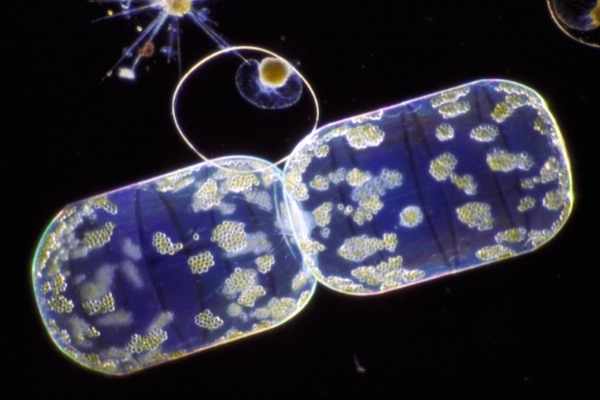
Cyanobacteria (Slime Mold)
Cyanobacteria, or slime molds, are another problematic live rock hitchhiker that can plague a new, immature tank.
There are two prominent types of cyanobacteria: blue-green and red-purple. One of the distinguishing characteristics of cyanobacteria is the formation of thick mats. The mat is a sheet of algae growing where it meets a new surface (such as the live rock, the substrate within the tank, or even the glass). Mats are somehow dull and shiny simultaneously, with bubbles stuck within the matrix (from respiration). They’re gross and a HUGE pain to cope with.

Macroalgae
The other name for macroalgae is seaweed. And you’ll find plenty of beneficial macroalgae out there. The greens ARE plants, which means they cycle nutrients throughout your tank. And they’ll work as breeding grounds for those pods you want to keep around. But they’re also FAST growers. And if you have excess nutrients in your aquarium, you’ll find yourself with a live rock hitchhiker that DOESN’T want to leave. Even the tiniest scrap of algae left behind will live to regrow and overtake the tank. (Fun times)
Hair Algae
Hair algae are green algae that resemble a wild patch of grass on your rocks. Scrape your rocks clean, and it pops up somewhere else. I’ve reached an age where the only hair (on my body) that grows as fast as hair algae are the hair on my ears and nose. (Gross visual, I know. Unnecessary, I know. Funny? Marginally. Oh well) That’s how troublesome this live rock hitchhiker ends up, though. And if you don’t stay on top of your nutrient levels, it will turn your tank into an overgrown disaster. We’re talking about the kind of lawn that gets you reported to the HOA.

Caulerpa Algae
Another problem group of live rock hitchhikers is Caulerpa algae. These frustrating stowaways can be a problem because they look pretty cool. They have leaf-like structures (they aren’t actually leaves) and spread through the tank by sending out runners. The runners attach to the live rocks like their life depends on it (which it actually DOES). Any tiny fragments that remain attached to the rock then regrow. It’s an amazing survival adaptation but a pain if you’re trying to remove it from your tank.

Bubble Algae
I need to admit something: I thought bubble algae were really cool the first time I saw them in my tank. They resemble emerald-colored pearls. And when you have just a few, they add a little bit of interest to your tank. However, like many pesky live rock hitchhikers, they enjoy living in our tanks and get out of control quickly. Even worse, you have to go CAREFUL with removal. Popping any of those bubbles will result in a massive bloom of the algae throughout your tank. (NOT what you want to happen!)
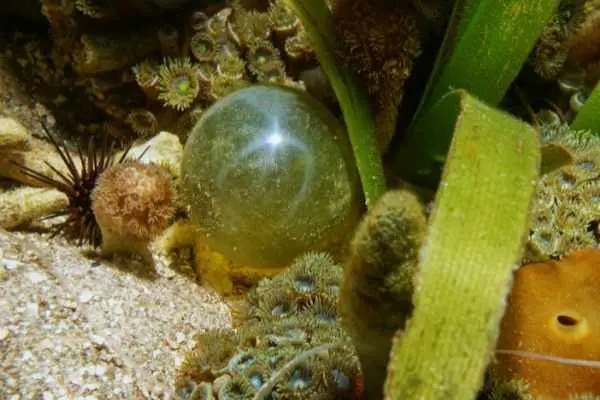
Halimeda Algae
Halimeda is not-as-problematic of an algae live rock hitchhiker. To me, they look like tiny underwater cacti. They grow in segments forming a long, “spiny” cluster.
In a pristine small polyp stony coral (SPS) set-up, they can look out of place. But in a tank with soft or large polyp stony (LPS) corals, they look pretty cool. They help remove nitrates and phosphates from the water. Unfortunately, they WILL compete with your corals for calcium. You’ll need to watch your calcium levels (you should anyway). But if you = treat them like anything else in your tank, they should do fine.
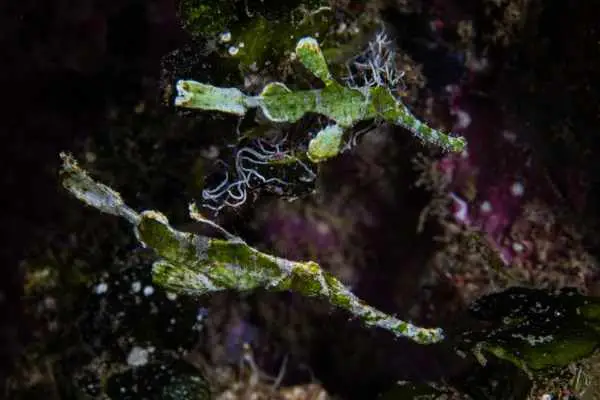
Neomeris Algae (Spindle Weed)
Neomeris algae are one of the strangest-looking live rock hitchhikers I’ve had in my tank. They look like strange green cotton swabs. I don’t know how else to describe them. They aren’t particularly harmful; they just come in from outer space. I’ve had them, and they didn’t post any problems. As a matter of fact, your tank will ignore them.
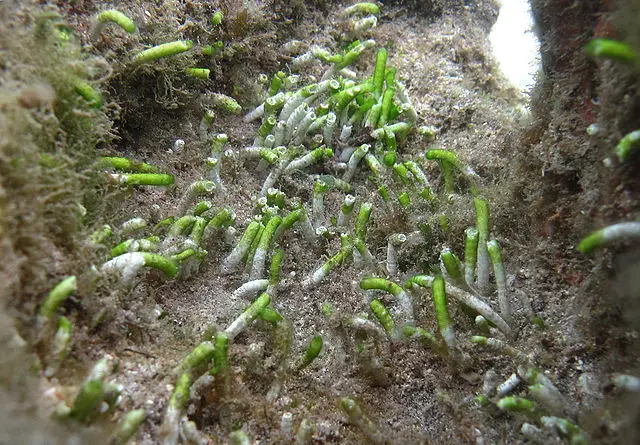
Problem Live Rock Hitchhikers
Now we’re down to the live rock hitchhikers you DON’T want to see setting up an invasion. These pests calmly hide away in the deepest reaches of the rock, waiting for the chance to emerge into the tank and wreak havoc. And once they’re established? You can struggle with eradicating them. Quarantine is a MUST to avoid these annoying houseguests. Even with a careful screening process, odds are you’ll end up with at least one of these live rock hitchhikers in your tank at SOME point in your hobby. (Don’t panic – it’s part of the aquarium life)
Glass Aiptasia Anemones and majanos
If you’re unlucky, you may end up with the dreaded glass or Aiptasia anemones. They don’t look like much – just one tiny anemone stowaway. At first glance – the first time I had one – I actually got excited (this was before I figured out what it was). And your first raw emotion CAN be of joy and triumph that you managed to keep a polyp of something alive on the live rock. After your excitement settles down, the next step is typically a Google search to learn more about your little live rock hitchhiker. And it’s quickly followed by dread at what you find.
Now, I think Aiptasia anemones are a bit misunderstood. They don’t really cause any ACTUAL problems in the tank. Their polyps sting nearby corals (but so do many coral species). The only two things they’re actually guilty of are:
- Stealing a free meal intended for your fish or corals
- Growing to plague proportions in your tank
Glass or Aiptasia anemones are one of the bigger pests of the modern-day aquarium. One small anemone (or even the PART of an anemone) can turn into a plague in your tank before you know it. They have MULTIPLE means of reproducing, and they’re tricky to eradicate. You don’t even get the benefit of dramatic colors out of the bargain. Always check your live rock – before this little anemone decides to take over.

Majano anemones are a close cousin to aiptasia–only there aren’t as many natural predators.
Mantis Shrimp
Loved by the devoted hobbyist with the luxury of keeping it in a dedicated tank, the dreaded mantis shrimp is the bane of the hobby. This ambush predator loves to stow away in the inner crevices of live rock. And once they’re in your aquarium? They’re difficult to track down again. Meanwhile, they happily dine on your favorite fish. You’ll hear a distinct “clicking” sound coming from your aquarium if you have a mantis shrimp.
DON’T attempt to reach in after one (assuming you spot it). They’re vicious crustaceans, capable of inflicting real damage on your fingers. You’ll want to set up a trap to lure them out of hiding.

Gorilla or Stone crabs
You might have glimpsed gorilla crabs out on a reef (or even in a commercial aquarium). When happy and healthy, they reach impressive sizes. But they start out tiny, allowing them to sneak in as live rock hitchhikers. And then they tear through a tank like tornadoes. That stone armor protects them from other predators in the tank as they feed on your anemones, clams, and other invertebrates.
And even though these guys get surprisingly big, they’ll evade detection in your tank for a long period of time (sort of like the mantis shrimp).

Vermetid snails
These tiny, predatory snails can kill your clams or other inverts. Learn more about Vermetid snails here.
For More Information
That’s only the TIP of the live rock hitchhiker iceberg, too. The aquarium galaxy’s a big place, with PLENTY more to explore. Good thing you have more options to delve into on this topic!
Interested in the helpful side of live rock hitchhikers? How about learning more about those pods in this YouTube Video:
Or are you ready to brave a deep dive into a YouTube video on all live rock hitchhikers?
How about investigating some methods of pest control? Plenty of live rock hitchhikers will “surrender” when faced with these reef tank residents:
- Dogface Pufferfish (for gorilla crabs)
- Filefish (for Aiptasia)
- Foxface rabbitfish (for Hair algae)
- Kole tang (for problem algae)
- Nassarius snails (for problem algae)
- Picasso Triggerfish (for gorilla crabs)
- Tailspot blenny (for problem algae)
Conclusion
Buying live rock is like a box of chocolates. You never know what you’re going to get. Sometimes those additions are good; sometimes, they’re bad. Live rock is ALWAYS interesting and expensive, and it’s one of the strange things we do. That means coping with live rock hitchhikers now and then. So long as you understand the mystery of the unknown (and keep your towel handy), you’re safe.
Have you ever had any live rock hitchhikers? If so, please leave a comment and let us know.


Leave a Reply